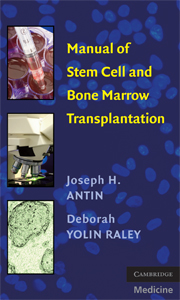Book contents
- Frontmatter
- Contents
- Acknowledgments
- Manual of Stem Cell and Bone Marrow Transplantation
- 1 Rationale for Transplantation
- 2 Types of Transplantation
- 3 HLA Matching in Allogeneic Transplantation
- 4 Stem Cell Source
- 5 Pretransplant Evaluation and Counseling of Patient and Donor
- 6 Conditioning Regimens
- 7 Stem Cell Infusion
- 8 ABO Compatibility
- 9 Engraftment
- 10 Preventative Care
- 11 Transplant-Related Complications
- 12 Graft-Versus-Host Disease – Prophylaxis and Acute
- 13 Graft-Versus-Host Disease – Chronic
- 14 Engraftment Syndrome
- 15 Infectious Disease
- 16 Graft Rejection And Failure
- 17 Gastrointestinal Complications
- 18 Pulmonary Complications
- 19 Veno-Occlusive Disease
- 20 Special Transfusion-Related Situations
- 21 Cardiovascular Complications
- 22 Neurologic Complications
- 23 Cystitis
- 24 Donor Lymphocyte Infusion
- 25 Transplantation: Regulation And Accreditation
- Appendix
- Index
17 - Gastrointestinal Complications
Published online by Cambridge University Press: 23 November 2009
- Frontmatter
- Contents
- Acknowledgments
- Manual of Stem Cell and Bone Marrow Transplantation
- 1 Rationale for Transplantation
- 2 Types of Transplantation
- 3 HLA Matching in Allogeneic Transplantation
- 4 Stem Cell Source
- 5 Pretransplant Evaluation and Counseling of Patient and Donor
- 6 Conditioning Regimens
- 7 Stem Cell Infusion
- 8 ABO Compatibility
- 9 Engraftment
- 10 Preventative Care
- 11 Transplant-Related Complications
- 12 Graft-Versus-Host Disease – Prophylaxis and Acute
- 13 Graft-Versus-Host Disease – Chronic
- 14 Engraftment Syndrome
- 15 Infectious Disease
- 16 Graft Rejection And Failure
- 17 Gastrointestinal Complications
- 18 Pulmonary Complications
- 19 Veno-Occlusive Disease
- 20 Special Transfusion-Related Situations
- 21 Cardiovascular Complications
- 22 Neurologic Complications
- 23 Cystitis
- 24 Donor Lymphocyte Infusion
- 25 Transplantation: Regulation And Accreditation
- Appendix
- Index
Summary
NAUSEA/VOMITING
Chemotherapy and/or radiation are typically emetogenic, and symptoms are expected early after hematopoietic stem cell transplantation. Medications such as antibiotics, opioids, MMF, mepron, and others can also contribute to nausea and vomiting. Acute upper gastrointestinal (GI) graft-versus-host disease (GVHD) typically manifests as nausea and can only be reliably diagnosed by biopsying the stomach. Infections with Herpes simplex virus (HSV), cytomegalovirus (CMV), adenovirus, Heliobacter pylori, and fungus are common offenders and need to be treated specifically.
Pattern
Acute onset occurs within 24 hours of chemotherapy administration (peak at 4 to 6 hours) and lasts for 24 to 48 hours. Usually responds to drug therapy.
Delayed onset occurs more than 24 hours after chemotherapy administration (peak at 2 to 3 days) and can last for several days. Variable response to drug therapy – commonly seen with cyclophosphamide, anthracyclines, and cisplatin.
Delayed after engraftment, usually associated with weight loss; may be GVHD.
Diagnostic Testing
Upper endoscopy with biopsy may be useful to assess for either GVHD or infectious etiologies.
Management
It is preferable to prevent as much nausea and vomiting as possible since treated established nausea is more difficult to manage. Moreover, prevention will decrease future anticipatory, breakthrough and delayed nausea/vomiting.
Anticipatory nausea/vomiting may best be controlled with anti-anxiety medications and behavioral interventions. Delayed nausea should be treated with scheduled antiemetics for 2 to 4 days after the completion of chemotherapy. Antiemetics used in combination provide greater protection than antiemetics used alone.
Information
- Type
- Chapter
- Information
- Manual of Stem Cell and Bone Marrow Transplantation , pp. 123 - 129Publisher: Cambridge University PressPrint publication year: 2009
